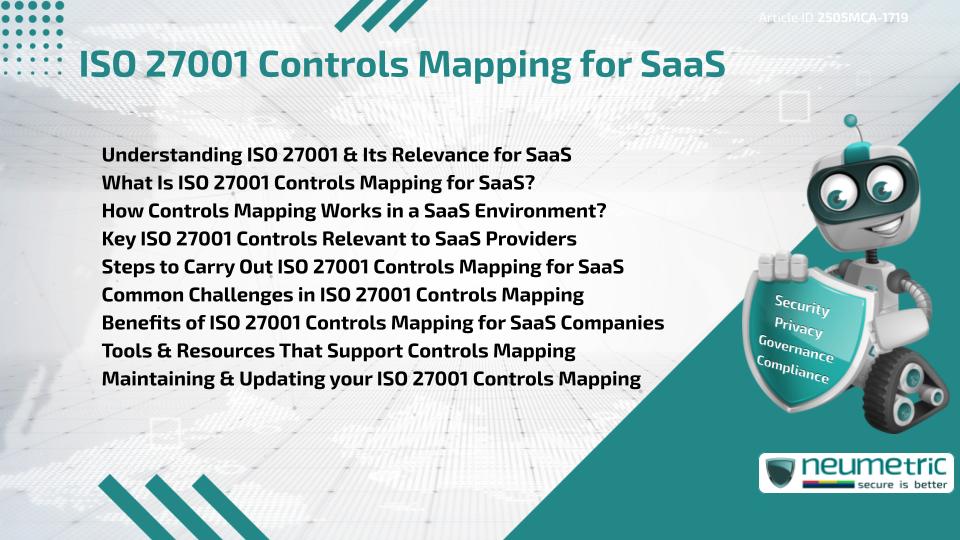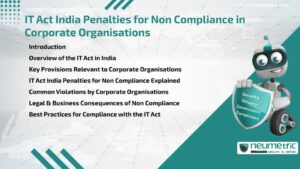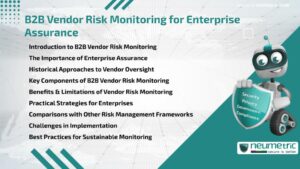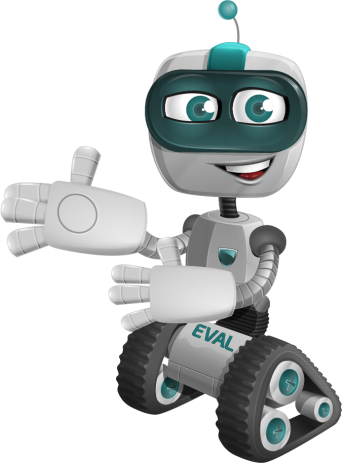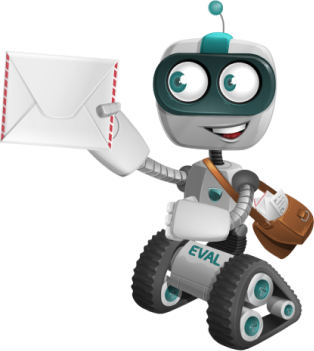Table of Contents
ToggleIntroduction
As cloud adoption continues to rise, Software as a Service [SaaS] companies are under increasing pressure to demonstrate strong Information Security practices. Aligning with the ISO 27001 Standard helps meet this expectation, but the real challenge lies in adapting the controls to cloud-native environments. This is where ISO 27001 controls mapping for SaaS comes in as a critical procedure for converting the ISO 27001 requirements into actionable practices within SaaS ecosystems.
This article explores what this mapping process involves, why it matters, & how SaaS businesses can use it to maintain robust security while ensuring Compliance & Customer confidence.
Understanding ISO 27001 & Its Relevance for SaaS
ISO 27001 is the globally recognised Standard for building & maintaining an Information Security Management System [ISMS]. It sets out a Risk-based Framework for identifying Threats, managing Vulnerabilities & implementing controls.
For SaaS Providers, ISO 27001 is particularly valuable. It provides a structured order to address the complexities while handling Customer Data, operating in multi-tenant environments & while using external infrastructure providers. Achieving Compliance can improve the credibility, streamline vendor Risk Assessments & reduce incidents of data breaches.
What Is ISO 27001 Controls Mapping for SaaS?
ISO 27001 controls mapping for SaaS refers to the process of aligning the standard’s Security Controls with the architecture, technologies & operational processes used by SaaS platforms. The goal is to ensure each control from Annex A of ISO 27001 is appropriately implemented, owned & monitored in the context of a cloud-based service delivery model.
Rather than applying controls in a generic fashion, SaaS businesses need to assess how controls apply to their deployment model — whether it’s single-tenant, multi-tenant or hybrid.
How Controls Mapping Works in a SaaS Environment?
Control mapping starts by reviewing the ISO 27001 Annex A controls & linking each control to equivalent practices or configurations in your SaaS setup. For example:
- Access Control (A.9) could be mapped to a role based access mechanism in the app & in the admin dashboards.
- Cryptographic controls (A.10) Could involve using SSL/TLS protocols to protect data while it’s being transmitted & AES-256 encryption to secure stored data.
- Operations security (A.12) could relate to automated monitoring, change control & system logging in your CI/CD pipelines.
This mapping process helps highlight areas where SaaS-specific implementations already satisfy ISO requirements, & where additional controls or documentation may be needed.
Key ISO 27001 Controls Relevant to SaaS Providers
While all ISO 27001 controls are important, certain ones are especially critical in a SaaS context. These include:
- A.6: Organisation of Information Security – Defining responsibilities & coordination among teams.
- A.8: Asset management – Tracking digital assets such as Customer databases & APIs.
- A.13: Communications security – Securing data flows between users & servers.
- A.14: System acquisition, development & maintenance – Applying security in DevOps cycles.
- A.17: Information Security aspects of Business Continuity – It ensures uptime & persistence.
Understanding how these controls map into cloud-based service models helps improve Compliance readiness & operational security.
Steps to Carry Out ISO 27001 Controls Mapping for SaaS
To execute ISO 27001 controls mapping for SaaS effectively, follow these steps:
- Conduct a Gap Analysis: Identify which controls are already addressed & where gaps exist.
- Contextualise Each Control: Understand how the control applies to your SaaS environment.
- Define Ownership & Implementation: Assign responsibilities to internal or external parties.
- Document Evidence: Use Policies, screenshots or logs to show control effectiveness.
- Review & Update Regularly: Integrate mapping into change management & internal audits.
Tools such as policy templates, control frameworks & cloud-specific security matrices can streamline the ISO 27001 controls mapping for SaaS processes effectively.
Common Challenges in ISO 27001 Controls Mapping
Despite its benefits, control mapping can be complex. Some typical challenges include:
- Ambiguity in Control Language: Interpreting vague control statements in a cloud context.
- Third Party Dependencies: Mapping controls involving shared responsibilities with IaaS providers.
- Tool Overload: Managing too many Compliance tools that don’t integrate well.
Overcoming these issues requires clarity in scope, Stakeholder collaboration & simplification of Compliance processes.
Benefits of ISO 27001 Controls Mapping for SaaS Companies
There are several advantages to engaging in ISO 27001 controls mapping for SaaS:
- Improved Security Posture: Controls become tightly aligned with real-world Risks.
- Faster Audit Readiness: Evidence of implementation is easy to present during audits.
- Customer Assurance: Demonstrates commitment to protecting Client data.
- Operational Efficiency: Reduces redundant security practices & improves team coordination.
These benefits compound over time, especially when mapping is embedded into product & engineering processes.
Tools & Resources That Support Controls Mapping
Modern SaaS Providers have access to various tools to simplify ISO 27001 controls mapping for SaaS, such as:
- Cloud Controls Matrix (CCM): Helps map ISO 27001 controls to cloud-specific security requirements across SaaS environments.
- NIST SP 800-53: Offers a detailed catalog of technical & administrative controls that align well with ISO 27001 frameworks.
- ISO/IEC 27002: Provides implementation guidance for ISO 27001 Annex A controls tailored to real-world practices.
- Cloud Security Posture Management (CSPM) Tools: Monitoring the cloud infrastructure continuously to ensure that the mapped controls are enforced & effective.
- CIS Controls: Delivers actionable, prioritised Best Practices that complement ISO 27001 for securing SaaS operations.
Maintaining & Updating your ISO 27001 Controls Mapping
The environment of SaaS changes rapidly due to ongoing deployments, dynamic infrastructure updates & evolving Customer expectations. Therefore, mapping should not be a one-time activity. Regular reviews, ideally every quarter or after major changes, help ensure continued relevance.
Involving Stakeholders across product, engineering & Compliance teams ensures that updates to architecture or tools are reflected in your ISO 27001 controls mapping for SaaS.
Takeaways
- ISO 27001 controls mapping for SaaS helps align cloud practices with ISO 27001 Compliance needs.
- Mapping must consider context, ownership & SaaS-specific implementations.
- Automation & visibility in ISO 27001 controls mapping for SaaS can be enhanced through tools that integrate with cloud environments & continuously track Compliance.
- Regular review of the mapping ensures that it stays aligned with fast-changing SaaS environments.
- The process enhances both Compliance readiness & actual security posture.
FAQ
What is ISO 27001 control mapping for SaaS?
It is the process of aligning ISO 27001 controls with the specific technologies & workflows used in SaaS platforms to ensure effective implementation.
How often should SaaS companies update their controls mapping?
Controls mapping should be reviewed at least quarterly or after any significant infrastructure or process changes.
Is ISO 27001 Certification required to do controls mapping?
No, controls mapping can be done independently to prepare for certification or improve internal security posture.
Do small SaaS companies also need ISO 27001 controls mapping?
Yes, especially if they handle sensitive Customer Data or aim to build trust with enterprise clients.
Can ISO 27001 controls mapping for SaaS be automated?
Yes, many tasks in ISO 27001 controls mapping for SaaS can be automated using platforms that sync with cloud services & monitor control implementation in real time.
Which ISO 27001 controls are most important for SaaS Providers?
Controls related to access, encryption, system development, & Third Party management are often critical in SaaS setups.
What is the difference between controls mapping & a Gap Analysis?
A Gap Analysis identifies missing controls, while mapping shows how existing controls align with ISO 27001.
How does ISO 27001 controls mapping improve Audit readiness?
By documenting how each control is implemented & monitored, mapping provides clear evidence for auditors.
Can Third Party tools like AWS help in ISO 27001 controls mapping?
Yes, cloud providers offer shared responsibility models & documentation that assist in control mapping
Need help?
Neumetric provides organisations the necessary help to achieve their Cybersecurity, Compliance, Governance, Privacy, Certifications & Pentesting goals.
Organisations & Businesses, specifically those which provide SaaS & AI Solutions, usually need a Cybersecurity Partner for meeting & maintaining the ongoing Security & Privacy needs & requirements of their Clients & Customers.
SOC 2, ISO 27001, ISO 42001, NIST, HIPAA, HECVAT, EU GDPR are some of the Frameworks that are served by Fusion – a centralised, automated, AI-enabled SaaS Solution created & managed by Neumetric.
Reach out to us!

